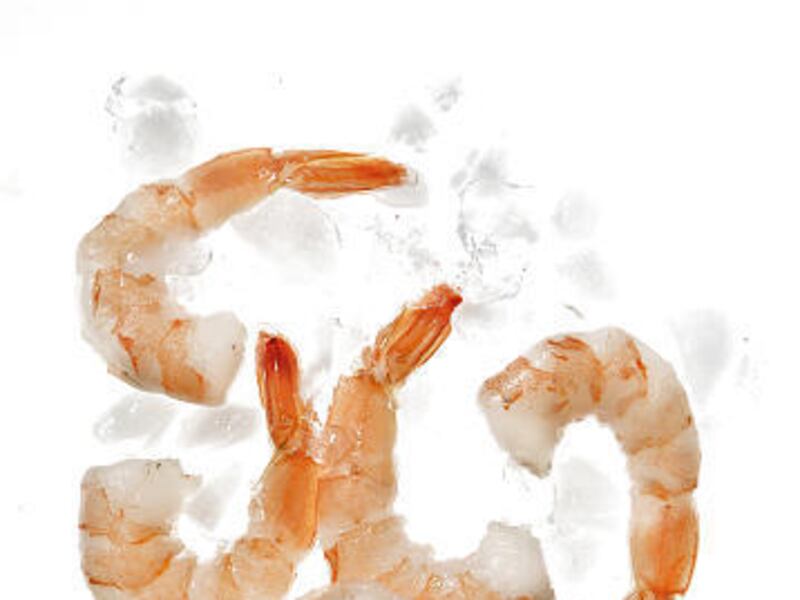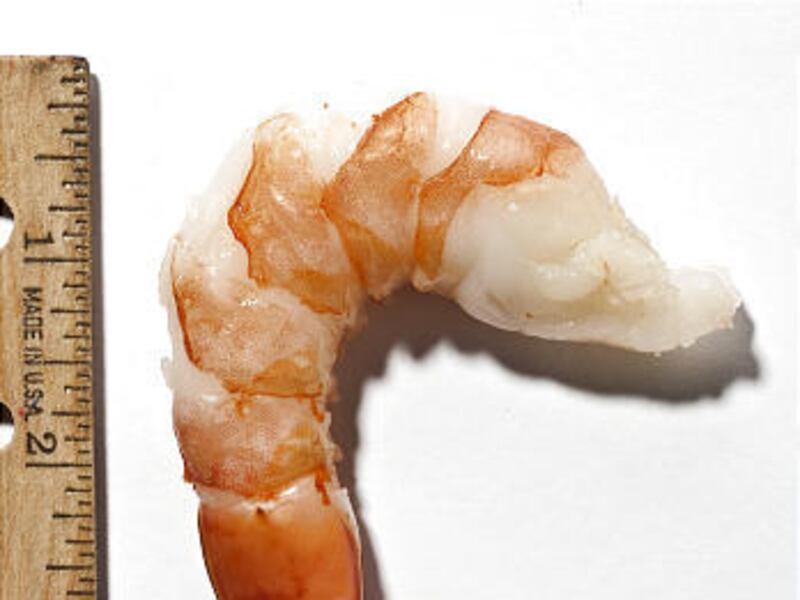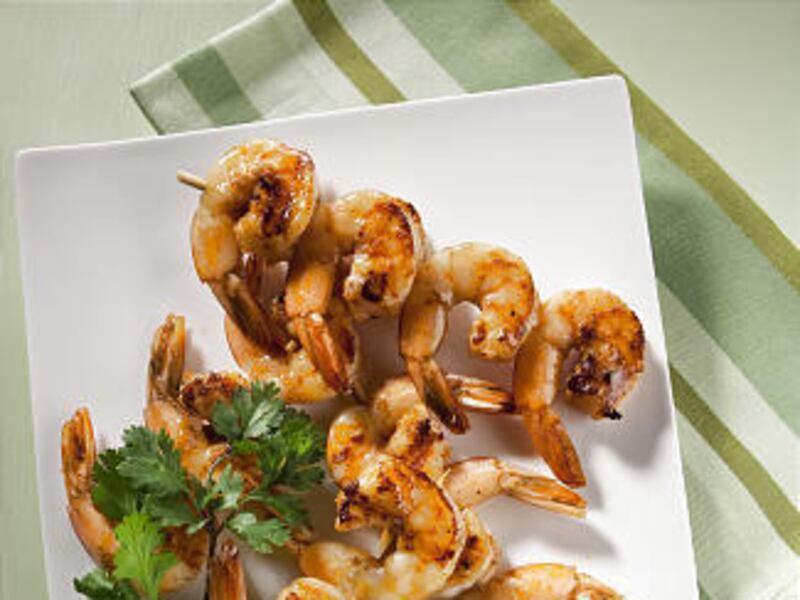America's favorite seafood? Shrimp. It's easy to see why; shrimp are available fresh or frozen, shell-on and peeled, raw and cooked. Shrimp lend themselves to countless dishes, from curries to gumbos to kebabs to stir fries.
"Mom and I loved shrimp," celebrity chef John Besh recalls in "My New Orleans," a combination cookbook, memoir and tribute to Louisiana's food culture. "Dad enjoyed them but Mom and I loved them, just because they are so easy to cook."
Louisiana is the major source for domestic shrimp. The state's shrimp industry was socked hard by hurricanes Katrina and Rita in 2005, as Besh noted in his book (written before the oil spill disaster in the Gulf of Mexico), and has been battered by cheaper foreign competition.
For Besh and others, shrimp is more than a food; it's a way of life.
"It's not just the critters we need to protect here but also the spirit of our shrimping community," Besh wrote.
The region's shrimpers are the equivalent of the family farm to Besh. "In our neck of the woods, that means everything," he said in a telephone interview."
Besh, whose restaurants include August, Luke, Domenica and Besh Steak, is not the only New Orleans chef gung-ho on the local product.
"I think it's important to know where the shrimp are from because I personally think the Gulf shrimp are the tastiest and the best," said Susan Spicer, who, as chef/owner of Bayona restaurant, has made a reputation for using underused and underappreciated fish species on her menus.
In terms of having environmental cred, wild and farmed shrimp from the United States and Canada get the nod from the Monterey Bay Aquarium's Seafood Watch program. Seafood Watch recommends avoiding shrimp from other countries.
Which shrimp is which? Consumers should ask at restaurants and retail outlets, said Sheila Bowman, outreach director for the California-based program. "The seafood supply chain has good information available that will tell you how it was caught, where it was caught," she said. "If a restaurant or a retailer can't tell you, it's because they haven't made it a priority to understand or know about the information."
"Not all shrimp are created equal," Besh insisted. "Domestic shrimp are much more scrutinized. Take the Gulf of Mexico for instance, where the shrimping season has just begun. Never have there been waters more controlled or tested on such a regular basis. They are making sure shrimp caught in these waters are not polluted." Of course, as the Gulf situation keeps unfolding new advisories or warning could be issued.
Spicer relies on a shrimper who goes farther west in the Gulf of Mexico, near Morgan City, La., to get shrimp.
"He delivers several times a week himself — which means he shrimps all night, then drives back to New Orleans and delivers to his restaurants all morning and afternoon. I don't know when the guy sleeps," she said.
Spicer likes using the Gulf's brown and white shrimps.
"I usually use a 16-20 count, which means there are between 16 to 20 shrimp per pound," she said. "If the shrimp are headless, a count of 21-25 is a good size. The smaller the number, the bigger the shrimp and the higher the price."
Besh uses both the brown shrimp, which tends to arrive at the market in May and June, and the larger white shrimp, which can be found from August onward. While larger shrimp are more popular, they also pose somewhat of a challenge.
"They're more prone to be tougher and chewier," he said. "If you go for medium-sized shrimp they'll be more forgiving and, frankly, there's sometimes less of that iodine flavor."
Whatever shrimp you buy, make sure to enjoy them to the max and showcase them for all their worth. For, as Bowman notes, the best way to treat the world's shrimp population may be not to eat them so often but relish them more.
"We have this all-you-can-eat-shrimp mentality," she said. "Shrimp is not a commodity that can withstand that kind of demand. We have to rethink overeating seafood like the salmon, tuna and shrimp that we love. We're loving them to death."
FDA — Gulf seafood is safe: The BP oil spill in the Gulf of Mexico is a major environmental disaster that has left chefs, consumers and experts wondering and worrying over the region's rich aquatic bounty. While a survey by the University of Minnesota's Food Industry Center found 44 percent of respondents wouldn't eat seafood from the Gulf, others are consuming it while keeping a watchful, waiting attitude.
The U.S. Food and Drug Administration says on its Web site that the Gulf situation and its impact on seafood safety are being closely monitored.
"Although crude oil has the potential to taint seafood with flavors and odors caused by exposure to hydrocarbon chemicals, the public should not be concerned about the safety of seafood in stores at this time," the FDA noted. "Fish and shellfish harvested from areas unaffected by the closures are considered safe to eat."
Chefs Collaborative, a Boston-based national network of chefs working on sustainability issues, has advised members to continue supporting Gulf fisheries.
"The testing has been so rigorous that our understanding is any seafood that's coming to market is safe to eat," said Melissa Kogut, the program's executive director.
While a huge quantity of oil was spilled, John Besh, the New Orleans-based restaurateur, said most people don't realize just how big the Gulf of Mexico is.
"The spill happened 45 miles offshore in water over 1 mile deep," he said. "That's not where the shrimping is done."
"A large portion of the fisheries is not affected," Besh said. "We need to spread the message the food here is good to eat."
How to buy shrimp: New Orleans chef John Besh offers tips on what to look for:
Dark brown heads, legs or tails can mean old shrimp. The color should be light, "almost transparent in a way," Besh said.
Use fresh shrimp immediately, if possible, or within a day.
Whole, fresh head-on shrimp should still have antennae attached; shrimp without them were likely frozen.
Besh said shrimp should smell "fresh and briny from the sea." Perform a "sniff test" at the counter, if you like. If the store refuses, try an old Julia Child trick: Buy the shrimp, open the package right there and complain, loudly, if unsatisfied.
Buy shrimp with the shells still on; use them to make a shrimp stock for use in recipes. "Shrimp shells have more flavor than the actual shrimp meat itself," Besh said. Here's his simple recipe: "Toast the shells in olive oil, add onion, garlic and celery. Cover with water and cook 45 minutes."
Frozen shrimp can be as good as fresh, Besh said. He prefers shell-on shrimp because they're less prone to freezer burn. He also prefers to thaw the shrimp himself when he's ready to use them, rather than buy thawed shrimp at the market.
Avoid precooked shrimp, Besh said. "I can't control it. I'm at the whim of someone else cooking my food."
Develop a relationship with a reputable fish dealer who cares about the freshness and quality of the product.
Source: Ralph Brennan's New Orleans Seafood Cookbook
How to peel shrimp: Twist off the head if present. Pull off the small legs running down the underside of the shrimp.
Peel off the shell with your fingers. Start at the top; work your way back to the tail.
Take off the "fan" of the tail, if you wish. Pinch or cut the "fan" and pull the shrimp gently away.
Devein large shrimp by running a sharp knife down the back. Pull out the dark vein. Rinse the shrimp with cold running water; drain.
GRILLED SHRIMP WITH CORIANDER SAUCE
Prep: 40 minutes
Cook: 25 minutes
Makes: 4 servings
Susan Spicer, of Bayona restaurant in New Orleans, serves this shrimp with black bean cakes prepared the night or morning before she plans to serve the dish.
2 tablespoons olive oil
¾ teaspoon ground coriander
1/2 teaspoon salt
¼ teaspoon each: chili powder, ground red pepper
16 medium shrimp, peeled, deveined, tails left on
Coriander sauce:
1 shallot, finely chopped
1/2 cup white wine
1/2 teaspoon grated orange zest
¼ cup orange juice
2 tablespoons sherry wine vinegar
1/2 teaspoon ground coriander
5 tablespoons butter, softened
2 tablespoons chopped cilantro
¼ teaspoon salt
Freshly ground pepper
1. Combine olive oil, ¼ teaspoon of the ground coriander, ¼ teaspoon of the salt, chili powder and red pepper in a medium bowl. Add shrimp; toss. Refrigerate while you make coriander sauce. Soak four 6-inch skewers in hot water.
2. For sauce, place the shallot, orange zest and juice, wine, vinegar and coriander in a small saucepan; heat to a simmer over medium heat. Cook until liquid is reduced to about 3 tablespoons, 20 minutes. Whisk in softened butter by the spoonful until sauce is emulsified and creamy. Stir in cilantro; stir in remaining ¼ teaspoon of the salt and pepper to taste. Keep warm.
3. Prepare a grill or broiler for high heat. Place four shrimp on each skewer. Grill or broil shrimp until just cooked through, 2-3 minutes per side. Drizzle with the sauce.
Nutrition information: Per serving: 192 calories, 84 percent of calories from fat, 18 g fat, 10 g saturated fat, 81 mg cholesterol, 3 g carbohydrates, 5 g protein, 198 mg sodium, 0 g fiber
CHARRED CHAYOTE SOUP WITH ADOBO SHRIMP
Prep: 30 minutes
Cook: 30 minutes
Makes: 4 servings
Emeril Lagasse included this recipe in his latest cookbook, "Farm to Fork: Cooking Local, Cooking Fresh." "Don't skip grilling the chayote — it adds a smoky element that really makes this combination sing," Lagasse writes. He often garnishes it with sour cream. A low-sodium chicken broth will reduce the sodium level.
2 1/2 pounds chayote squash, peeled, halved, seeded
1 tablespoon oil
1 ¾ teaspoons salt
¼ teaspoon freshly ground black pepper
1 pound medium shrimp, peeled, deveined
2 teaspoons sauce from canned chipotles in adobo sauce
2 tablespoons unsalted butter
2 yellow onions, chopped
1 clove garlic, minced
1/2 teaspoon ground cumin
¼ teaspoon crushed red pepper
1 quart chicken stock or canned low-sodium chicken broth
1 tablespoon finely chopped fresh cilantro leaves
1. Prepare a grill or grill pan for medium heat. Combine the chayote, oil, 1/2 teaspoon of the salt and black pepper in a large bowl; toss. Grill the chayote, in batches if necessary, until slightly charred on both sides, 8-10 minutes per side. Cut into 1/2-inch dice; set aside.
2. Combine the shrimp, ¼ teaspoon of the salt and adobo sauce in a bowl. Let stand 10-30 minutes.
3. Heat the butter in a medium stockpot over medium-high heat. Add the onions and remaining 1/2 teaspoon of the salt. Cook until onions soften, about 3 minutes. Add the garlic. Cook, stirring, 30 seconds. Add the reserved chayote, the cumin and the crushed red pepper. Stir in the chicken stock; heat to a boil. Reduce heat to medium-low; simmer until chayote is tender, about 8 minutes.
4. Add the shrimp. Cook until they turn pink, about 2 minutes. Remove the soup from the heat; stir in cilantro. Serve hot.
Nutrition information: Per serving: 335 calories, 38 percent of calories from fat, 14 g fat, 5 g saturated fat, 191 mg cholesterol, 26 g carbohydrates, 26 g protein, 1,581 mg sodium, 8 g fiber
GARLIC LEMON SHRIMP
Prep: 35 minutes
Cook: 5 minutes
Makes: 6 servings
Restaurateur Ralph Brennan prefers using jumbo shrimp with heads and tails left on for this dish from his "New Orleans Seafood Cookbook," but writes "somewhat smaller ones can be used in a pinch." We used about half the vinaigrette; refrigerate the remainder for salads.
For the citrus vinaigrette:
1/2 cup chopped fresh Italian parsley
3 tablespoons each: freshly squeezed lemon juice, key lime juice
2 tablespoons finely chopped fresh garlic
1 ¼ cups extra-virgin olive oil
¼ teaspoon salt
1/8 teaspoon black freshly ground pepper
For the shrimp:
¼ cup olive oil
30 jumbo shrimp, peeled, deveined
1/2 teaspoon each: salt, black freshly ground pepper
3 lemons, halved
1. For the vinaigrette, mix parsley, lemon and lime juices and garlic in a large bowl. Gradually add the olive oil in a thin, steady stream, whisking constantly until all is incorporated and the mixture looks creamy. Whisk in salt and pepper. Refrigerate overnight in a covered container.
2. For the shrimp, heat the olive oil in a large skillet over high heat until just short of smoking, about 2 minutes. Add the shrimp in a single layer as much as possible. Sprinkle salt and pepper over the shrimp. Cook, without stirring, 1 minute. Reduce the heat to medium-high; turn shrimp. Cook until pink, about 3 minutes.
3. Add 1 1/2 cups of the vinaigrette to the pan. Cook until the vinaigrette just begins to bubble and the shrimp are barely done, about 45 seconds, moving the shrimp around with a spoon so the vinaigrette flows evenly around all the shrimp. Remove from heat; let the shrimp sit in the pan 30 seconds; pour the shrimp and sauce into a large shallow pasta bowl or serving platter. Garnish with lemon halves.
Nutrition information: Per serving (using half of the vinaigrette): 311 calories, 91 percent of calories from fat, 32 g fat, 4 g saturated fat, 54 mg cholesterol, 1 g carbohydrates, 6 g protein, 306 mg sodium, 0 g fiber
SHRIMP CREOLE
Prep: 45 minutes
Cook: 20 minutes
Makes: 12 servings
This recipe from chef John Besh's "My New Orleans" cookbook is designed for a "typical" Sunday supper at his house. You can always halve the ingredients to make enough for 6 to 8 people. "Traditionally a roux-and-tomato-based dish, shrimp Creole in my new version has Vietnamese influences," Besh writes. "It's spicy and sweet, full of herbs and flavor."
5 pounds jumbo Louisiana or wild American shrimp, peeled, deveined
1 teaspoon salt
Freshly ground black pepper
1 tablespoon minced fresh lemongrass
1/2 cup olive oil
3 yellow onions, diced
10 cloves garlic, thinly sliced
1 rib celery, diced
1 bell pepper, red, green or yellow, seeded, diced
5 pounds overripe tomatoes, peeled, seeded, chopped
1 bay leaf
¼ teaspoon ground allspice
1 tablespoon red pepper flakes
Leaves from 2 sprigs basil, chopped
Leaves from 1 sprig mint, chopped
Sugar, optional
2 cups long-grain rice, cooked
1. Put the shrimp into a large bowl; season with salt and pepper. Mix in the lemongrass. Heat ¼ cup of the olive oil in a large deep skillet over medium heat. Add the shrimp; cook, stirring and tossing, until they turn pink, about 2 minutes. Remove the shrimp from the pan; set aside.
2, Add remaining ¼ cup of the olive oil, onions, garlic, celery and bell peppers. Cook, stirring, 2 minutes. Add the tomatoes. Reduce the heat to medium-low. Heat to a simmer; add the bay leaf, allspice and red pepper flakes. Simmer 10 minutes.
3. Put the shrimp back in the skillet; add the basil and mint. Cook until warm, about 2 minutes. Season with salt and pepper. If the sauce tastes too tart, add a little sugar to balance the flavor. Remove the bay leaf. Serve over rice.
Nutrition information: Per serving: 259 calories, 31 percent of calories from fat, 9 g fat, 1 g saturated fat, 244 mg cholesterol, 18 g carbohydrates, 27 g protein, 425 mg sodium, 3 g fiber
Shrimp by the numbers
Names can change, but numbers are immutable, especially when it comes to buying shrimp. A set of numbers, called the count, tells you the size of what you're buying. The count is based on the number of shrimp (without heads) per pound. Look for the count, often written as 31/35 or 10/12, on packaging, labels, store signs.
10-12: Colossal
11-15: Jumbo
16-20: Extra-large
21-30: Large
31-35: Medium
36-45: Small
46-100: Miniature
Source: Ralph Brennan's "New Orleans Seafood Cookbook"'Green' shrimp shopping
Stumped about what type of shrimp is the most environmentally sound choice in the supermarket, fish store or restaurant? Monterey Bay Aquarium's Seafood Watch program breaks down the options into three categories: "Best Choices," "Good Alternatives" and "Avoid."
The factors used to sort out where each type of shrimp belongs, especially where and how it was caught, can be used to judge the green credentials of other seafood too.
For more information on shrimp and other sustainable seafood choices, go the aquarium's Web site, montereybayaquarium.org. Print out a pocket-size Seafood Watch guide for your area of the country.
Best choices:
Type of shrimp — Market Names — Where Caught — How Caught
Freshwater prawn — giant river prawn, Malaysian prawn — U.S. — farmed
Pink shrimp — bay shrimp, cocktail shrimp, ocean shrimp, salad shrimp, ebi — Oregon — wild-caught
Shrimp — Pacific white shrimp, West Coast white shrimp, ebi — U.S. — closed systems (water treated before discharge), inland ponds
Spot prawn — prawn, spot shrimp, amaebi — British Columbia — wild-caught
Good alternative:
Northern shrimp — bay shrimp, cocktail shrimp, salad shrimp, ebi — U.S., Canadian Atlantic Ocean — wild-caught
Rock shrimp — rock shrimp — U.S. — wild-caught
Shrimp — Pacific white shrimp, West Coast white shrimp, ebi — U.S. —open systems (farmed with exposure to the sea or open water; no water treatment)
Shrimp — White shrimp, brown shrimp, pink shrimp, rock shrimp, ebi — U.S. Gulf of Mexico, U.S. South Atlantic — wild-caught
Spot prawn — prawn, spot shrimp, amaebi — U.S. Pacific — wild-caught
Avoid:
Shrimp — black tiger shrimp, tiger prawn, white shrimp, ebi — imported-farmed
Shrimp — black tiger shrimp, tiger prawn, white shrimp, ebi — imported-wild-caught
Source: Monterey Bay Aquarium Seafood Watch program
Distributed by McClatchy-Tribune Information Services.



